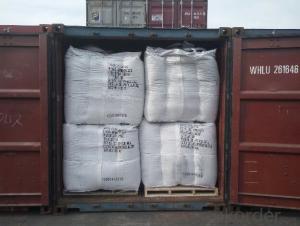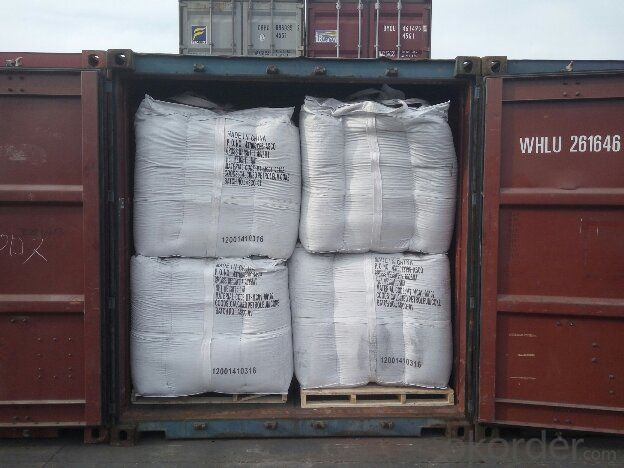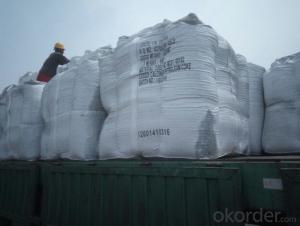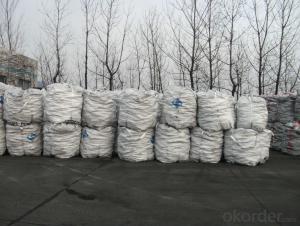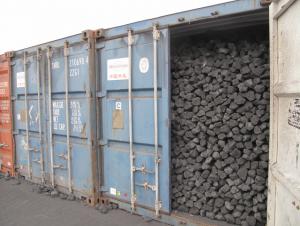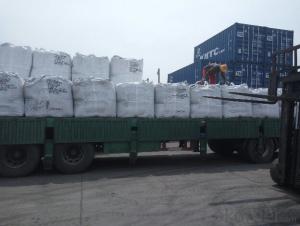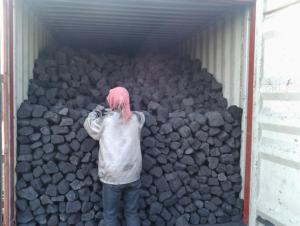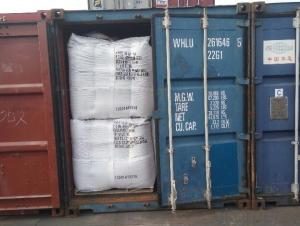12% Ash Foundry Coke for Foundry Plant Around the World
- Loading Port:
- Tianjin
- Payment Terms:
- TT OR LC
- Min Order Qty:
- 20.8
- Supply Capability:
- 1008 m.t./month
OKorder Service Pledge
OKorder Financial Service
You Might Also Like
Brief Introduction
Foundry Coke is the main fuel of melting iron in the oven. It can melt the materials in the over, make the iron reach great heat, and keep good air permeability by sustain stock column. Thus, the foundry coke should have the characteristics of big block, low reactivity, small porocity, enough anti-crush strengh, low ash and low sulphur.
The coke handled by our cooperation is made from superior coking coal of Shanxi province. Provided with the advantages of low ash, low sulphur and high carbon. Our coke is well sold in European, American, Japanese and South-east Asian markets. We are expanding more and more markets. we supply Foundry Coke long-term, its characteristic is best strength, low sulfur and phosphorus,thermal stability.
Specifications:
ASH % | 8% max | 10% max | 12% max |
V.M.% MAX | 1.5% max | 1.5% max | 2% max |
SULFUR % | 0.65% max | 0.65% max | 0.7% max |
MOISTURE | 5% max | 5% max | 5% max |
Size | 80mm-120mm,80-150,100-150mm, or as request | ||
Features
1. Our quality is always quite good and stable which is producing and packing according to customers' requirements.
2. Putting Client profile into first, achieved mutual benefit.
3. Good partner on business. It's a good and wise choice for customers' to purchase from us. It's our great honor to cooperate with you.
4. We can supply documents as follows:
- bill of loading,
-Invoice,
-Packing List
-Insurance
-standard inspection pictures of the container as specified by INSPECTORATE
-or more requested by buyer.
Pictures

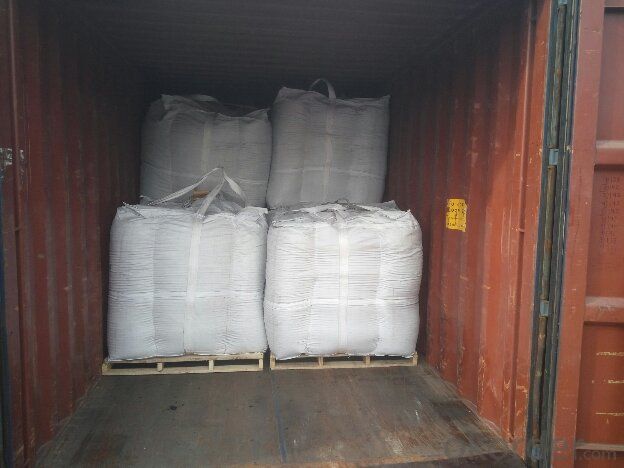
FAQ
1. What is the packing?
In 25kg bag/ In jumbo bags without pallet/ Two jumbo bags with one pallet/ or as customers’ request
2. What is the production capacity?
10 thousand tons per month
3 What is payment term?
Irrevocable LC at sight/ 20% down payment by T/T and 80% against BL copy byT/T/ or to be discussed
4 What is the service?
We will send sample to the third party(CIQ, CCIC, SGS,BV or to be discussed) for checking, and present the test certificate and loading repot of shipment.
- Q: What are the different types of carbon-based inks?
- There are various types of carbon-based inks, including carbon black ink, graphite ink, and carbon nanotube ink.
- Q: How is carbon used in the agricultural industry?
- Various purposes in the agricultural industry make carbon widely used. One of its main uses in agriculture is as a soil amendment. The addition of carbon-rich organic matter, like compost or manure, improves soil structure, fertility, and overall health. This occurs because carbon increases the soil's capacity to retain moisture, nutrients, and beneficial microorganisms, all of which are vital for plant growth. In addition to soil amendment, carbon is also utilized in the form of carbon dioxide (CO2) for greenhouse enrichment. In controlled environments such as greenhouses, plants require higher concentrations of CO2 to enhance growth and productivity. Carbon dioxide is introduced into the greenhouse to maintain optimal levels, facilitating photosynthesis and accelerating plant growth. Furthermore, carbon-based fertilizers are commonly employed in agriculture. Fertilizers like urea or ammonium nitrate provide essential nutrients to crops and enhance productivity. Carbon serves as a crucial component in these fertilizers, aiding in the controlled release and effective uptake of nutrients by plants. Moreover, carbon is employed in the production of pesticides and herbicides. Many of these agricultural chemicals contain carbon compounds specifically designed to target and control pests, diseases, and weeds that can harm crops. Carbon-based chemicals are preferred due to their effectiveness and ability to naturally break down without causing long-term harm to the environment. In summary, carbon plays a vital role in the agricultural industry by enhancing soil fertility, promoting plant growth, and aiding in pest control. Its versatility makes it an indispensable resource for sustainable and efficient farming practices.
- Q: Carbon content of fly ash and fly ash roasted vector what is the relationship?
- The loss of coal ash is mainly caused by the incomplete combustion of coal, the remaining carbon is introduced, and the carbon content is high, then the amount of burning is high. From the color, it can be clearly seen that the black fly ash has high carbon content and high ignition loss. Based on the molecular weights of C and CO2, a preliminary estimate is made.
- Q: How does carbon affect air quality?
- Air quality can be affected both positively and negatively by carbon. On the one hand, carbon dioxide (CO2) is a natural part of the Earth's atmosphere and vital for plant survival and photosynthesis. Nevertheless, an excess of CO2 can contribute to the greenhouse effect, resulting in global warming and climate change. Furthermore, carbon monoxide (CO), a harmful pollutant produced during incomplete combustion, can have a detrimental impact on air quality. It is primarily released by vehicles, industrial processes, and residential heating systems. Elevated levels of carbon monoxide can impede the body's oxygen delivery, causing various health problems such as headaches, dizziness, and in severe cases, even death. Additionally, compounds containing carbon, like volatile organic compounds (VOCs), can play a role in the creation of ground-level ozone, which is a harmful pollutant. Ground-level ozone can lead to respiratory issues, worsen existing respiratory conditions, and reduce lung function. VOCs are emitted by different sources, including vehicle emissions, industrial processes, and specific household products. In conclusion, while carbon dioxide is crucial for life on Earth, excessive amounts can contribute to climate change. Conversely, carbon monoxide and volatile organic compounds released by human activities can have adverse effects on air quality and human health. Therefore, it is crucial to decrease carbon emissions and adopt cleaner technologies to mitigate the negative impacts of carbon on air quality.
- Q: What are the effects of carbon emissions on the stability of the atmosphere?
- Carbon emissions have significant effects on the stability of the atmosphere. The primary consequence is the intensification of the greenhouse effect, leading to global warming and climate change. Carbon dioxide (CO2), the main greenhouse gas emitted by human activities, traps heat in the atmosphere, preventing it from escaping into space. As a result, the Earth's average temperature rises, causing a range of adverse impacts. One effect of carbon emissions is the alteration of weather patterns. Increased atmospheric temperatures can result in more frequent and intense heatwaves, droughts, and wildfires. Conversely, it can also lead to heavier rainfall and more frequent and intense storms, including hurricanes and cyclones. These changes in weather patterns disrupt ecosystems, agriculture, and water availability, posing risks to human health, food security, and infrastructure. Another consequence of carbon emissions is the melting of polar ice caps and glaciers. As the atmosphere warms, ice sheets in Antarctica and Greenland melt, contributing to rising sea levels. This poses a significant threat to coastal regions, increasing the risk of inundation, erosion, and the loss of valuable ecosystems. The displacement of coastal communities and the loss of land also create social and economic challenges. Furthermore, carbon emissions contribute to ocean acidification. When CO2 is absorbed by seawater, it reacts with water molecules, forming carbonic acid. This process lowers the pH of the ocean, making it more acidic. Acidic waters harm marine life, particularly coral reefs and other organisms that rely on calcium carbonate to build their shells and skeletons. The degradation of coral reefs not only affects marine biodiversity but also impacts the livelihoods of communities dependent on fisheries and tourism. The stability of the atmosphere is also impacted by the feedback loops triggered by carbon emissions. For instance, as the Earth warms, permafrost in the Arctic regions starts to thaw, releasing large amounts of methane, another potent greenhouse gas. This release of additional greenhouse gases further amplifies global warming, creating a vicious cycle. In summary, carbon emissions have profound effects on the stability of the atmosphere. They contribute to global warming, altering weather patterns, causing the melting of ice caps, acidifying the oceans, and triggering feedback loops. Addressing carbon emissions through sustainable practices, renewable energy sources, and international cooperation is crucial to mitigate these effects and ensure a stable and habitable atmosphere for future generations.
- Q: What is carbon dating and how does it work?
- The age of organic materials, like wood, cloth, and bone, can be determined using carbon dating, a scientific method. This method measures the quantity of carbon-14 (C-14) present in the sample. It is based on the principle that all living organisms contain a small amount of radioactive carbon-14, which is created in the upper atmosphere when nitrogen atoms are hit by cosmic rays. Over time, this radioactive form of carbon decays and transforms into nitrogen-14. To begin the process of carbon dating, a sample is collected from the object of interest. Typically, this sample consists of organic matter that was once part of a living organism. The sample is then treated to remove any impurities and made ready for analysis. Scientists measure the ratio of C-14 to stable carbon-12 (C-12) in the sample to determine its age. This measurement is carried out using an accelerator mass spectrometer (AMS), an instrument with high sensitivity that can detect and measure extremely low levels of C-14. By comparing the ratio of C-14 to C-12 in the sample with the known ratio in the atmosphere at the time the organism died, scientists can calculate the time that has passed since the organism's death. The half-life of C-14, which is the time it takes for half of the radioactive isotope to decay, is approximately 5,730 years. This means that after 5,730 years, half of the C-14 in a sample will have transformed into nitrogen-14. By measuring the remaining amount of C-14 in a sample and knowing its half-life, scientists can estimate its age. Carbon dating is an invaluable tool for archaeologists, paleontologists, and geologists as it enables them to accurately determine the age of ancient artifacts, fossils, and geological formations. However, it is important to note that carbon dating is effective only for materials up to around 50,000 years old since beyond this point, the remaining amount of C-14 becomes too small to measure accurately.
- Q: What are the effects of carbon emissions on the stability of grasslands?
- Carbon emissions have a significant impact on the stability of grasslands. One of the main effects is the alteration of the climate, specifically through the greenhouse effect. Carbon dioxide (CO2) is a major greenhouse gas, and the increased concentration of CO2 in the atmosphere leads to global warming. This rise in temperature affects grasslands by altering their natural growth patterns and disrupting the delicate balance of their ecosystems. Higher temperatures caused by carbon emissions can lead to increased evaporation rates, resulting in drier soil conditions. Grasslands are adapted to specific moisture levels, and any changes in these conditions can lead to reduced plant growth and increased susceptibility to drought. As a consequence, grasslands become less stable and more prone to desertification. Moreover, elevated levels of carbon dioxide can affect the nutritional quality of grasses. As CO2 concentrations increase, the relative proportion of essential nutrients in grasses may decrease. This phenomenon, known as nutrient dilution, can impact the health and productivity of herbivores that rely on these grasslands for sustenance. The decline in nutritional value can disrupt the delicate balance of predator-prey relationships and lead to a decline in biodiversity. Additionally, carbon emissions contribute to the acidification of soils. Increased carbon dioxide dissolves in rainwater, forming carbonic acid, which lowers the pH of the soil. Grasses are sensitive to changes in soil pH, and acidification can negatively affect their growth and nutrient uptake. Acidic soil conditions can also lead to the loss of important microorganisms that contribute to a healthy soil ecosystem, further destabilizing grasslands. Lastly, carbon emissions have indirect effects on grasslands through climate change-induced alterations in precipitation patterns. Changes in rainfall patterns can lead to shifts in plant composition and distribution, favoring invasive species or altering the competitive balance between different grass species. This can disrupt the stability and functioning of grassland ecosystems. In conclusion, carbon emissions have numerous detrimental effects on the stability of grasslands. These include changes in climate, increased vulnerability to drought, nutrient dilution, soil acidification, and alterations in precipitation patterns. It is crucial to reduce carbon emissions and mitigate the impacts of climate change to preserve the stability and integrity of grassland ecosystems.
- Q: How dnf advanced carbon ashes?
- Mall has sold, and sometimes activities, and now there is no
- Q: What is a carbon electrode? What's the use? What's the current situation in the industry? Try to be specific. Thank you
- According to the composition of the electrode material, the electrode can be divided into three categories.The first kind of electrode is metal electrode and gas electrode, such as zinc electrode and copper electrode in Daniel cell, and standard hydrogen electrode;The second kind of electrodes are metal metal insoluble salt electrode and metal metal refractory oxide electrode, such as Ag-AgCl electrode.Third kinds of electrode is redox electrode (oxidation of any electrode was as redox electrode, here said the reduction electrode is refers to taking part in the electrode reaction substances are in the same solution), such as Fe3+, Fe2+ electrode solution composition.An electrode is a conductor in which an electric current enters or leaves an electrolyte during electrolysis. Electrolysis is the oxidation reduction reaction at the electrode interface.The electrode is divided into a cathode and an anode, and the anode is connected with the anode of the power supply, and the anode is oxidized. The cathode is connected with the cathode of the power supply, and the reduction reaction is arranged on the cathode.There are many kinds of electrolytic materials. Carbon electrodes are commonly used. In addition, titanium and other metals can also be used as electrodes. In electroplating, the metal containing the coating metal is often used as an anode, and the plated product is used as the cathode.
- Q: What are the specifications of carbon fiber cloth?
- The units of weight are in units of g per square meter
Send your message to us
12% Ash Foundry Coke for Foundry Plant Around the World
- Loading Port:
- Tianjin
- Payment Terms:
- TT OR LC
- Min Order Qty:
- 20.8
- Supply Capability:
- 1008 m.t./month
OKorder Service Pledge
OKorder Financial Service
Similar products
Hot products
Hot Searches
Related keywords
